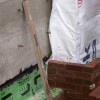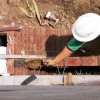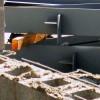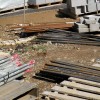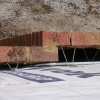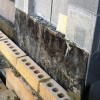Masonry Anchorage and Reinforcing
Masonry anchorage and reinforcing perform the critical function of adding strength to masonry, either by transferring forces to the structure or by directly contributing resistance to applied loads. These systems are usually concealed within the masonry and therefore must be selected to resist corrosion, which could lead to catastrophic failure. Replacement of materials built into or embedded in masonry work is a very expensive and disruptive process.

Topic Summary
Building codes require anchors and joint reinforcing in exterior masonry walls to either be of a noncorrosive metal, such as stainless steel, or be coated to protect against corrosion. Coating methods include powder coating, applied coating, and hot dipping.
Steel can be powder coated or an applied coating, such as epoxy-polymers, can be used. Hot-dip galvanizing is readily available and is typically chosen for most projects. Stainless steel is usually only available by special order at a high cost and therefore is used only for the most critical applications. The term "Brite Finish," used by many manufacturers, simply means bare, unprotected metal.
Vertical reinforcing bars fully embedded in high-strength grout do not usually require protection because they have sufficient grout cover to protect them from moisture.
Continuous welded-wire joint reinforcement is installed horizontally within the mortar between courses of masonry walls, typically at each 16 inches of wall height, or every two courses of standard block. It provides reinforcement for crack control and ties masonry veneer to backup in composite construction or cavity walls. It is available in a broad range of designs, sizes, wire thicknesses, and finishes.
Two-wire ladder or truss type continuous reinforcing is most often used in single-wythe masonry. Ladder type is adequate for shrinkage crack resistance in most applications. Truss type reinforcing is stronger, but may interfere with placement of vertical reinforcing bars in reinforced masonry walls. Ladder type or truss type continuous reinforcement with adjustable ties is recommended for composite masonry or cavity wall construction. This type of reinforcement accommodates minor deviations in coursing heights and allows some differential movement between the masonry backup and facing, which is needed for wall construction with cavity insulation.

